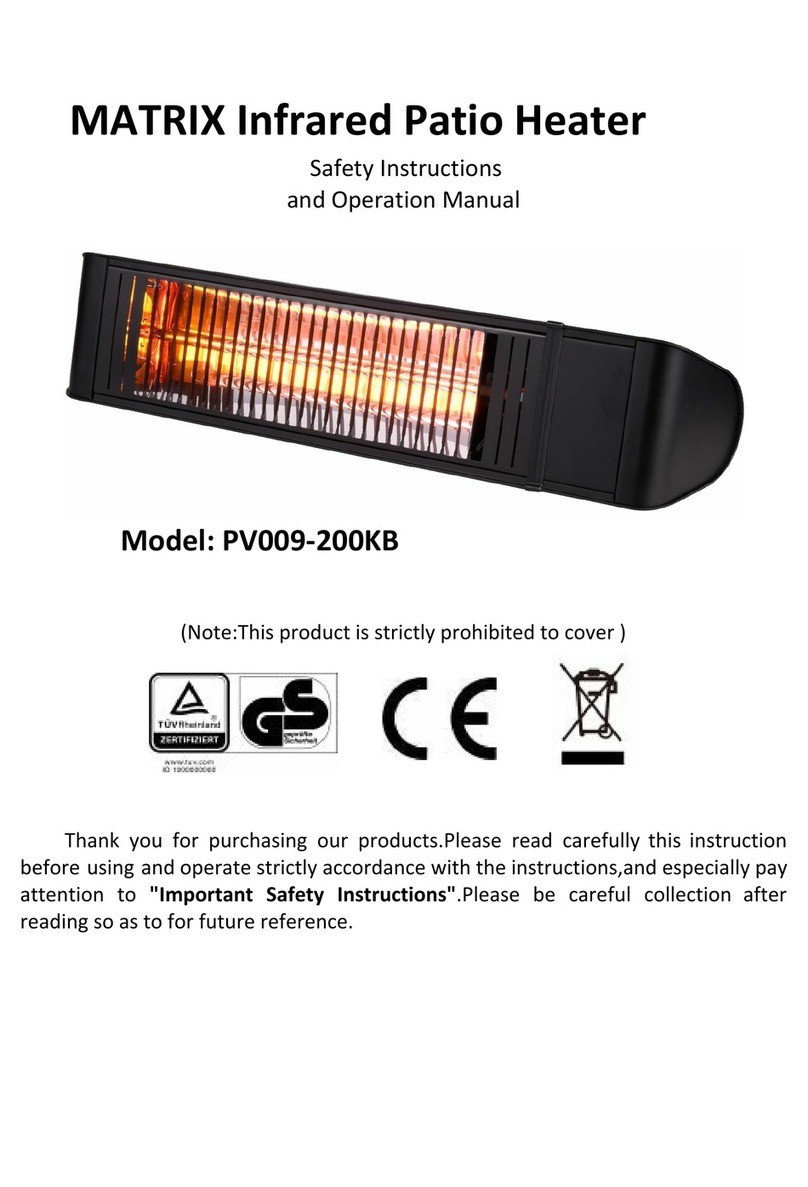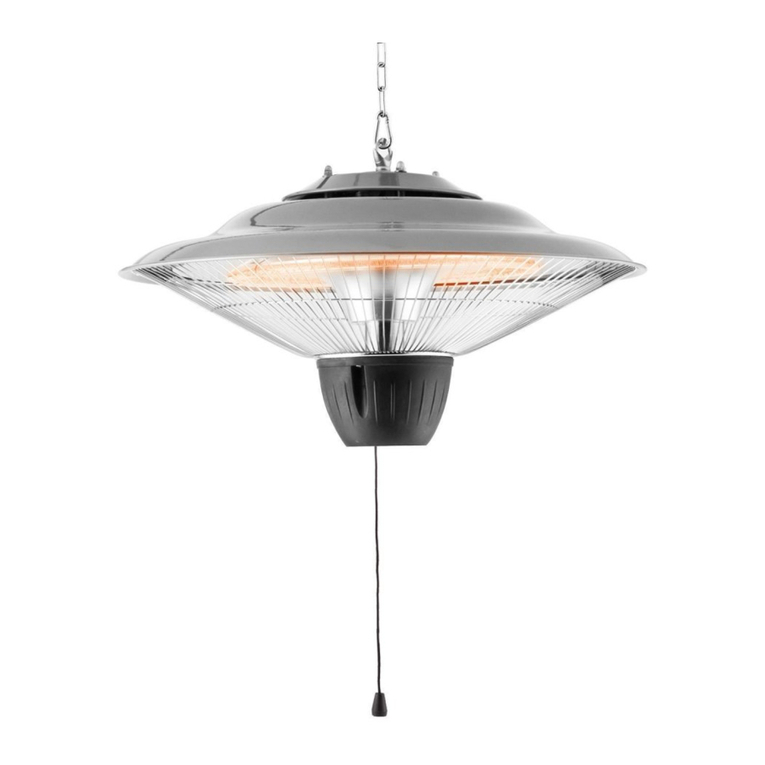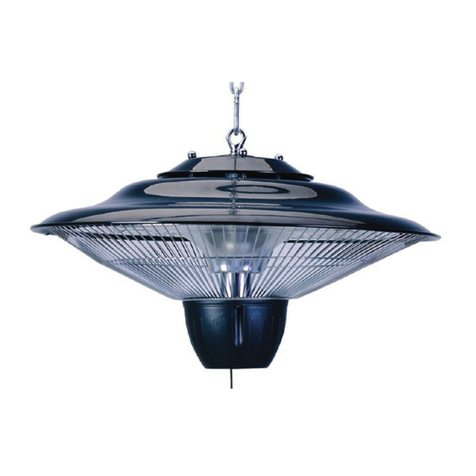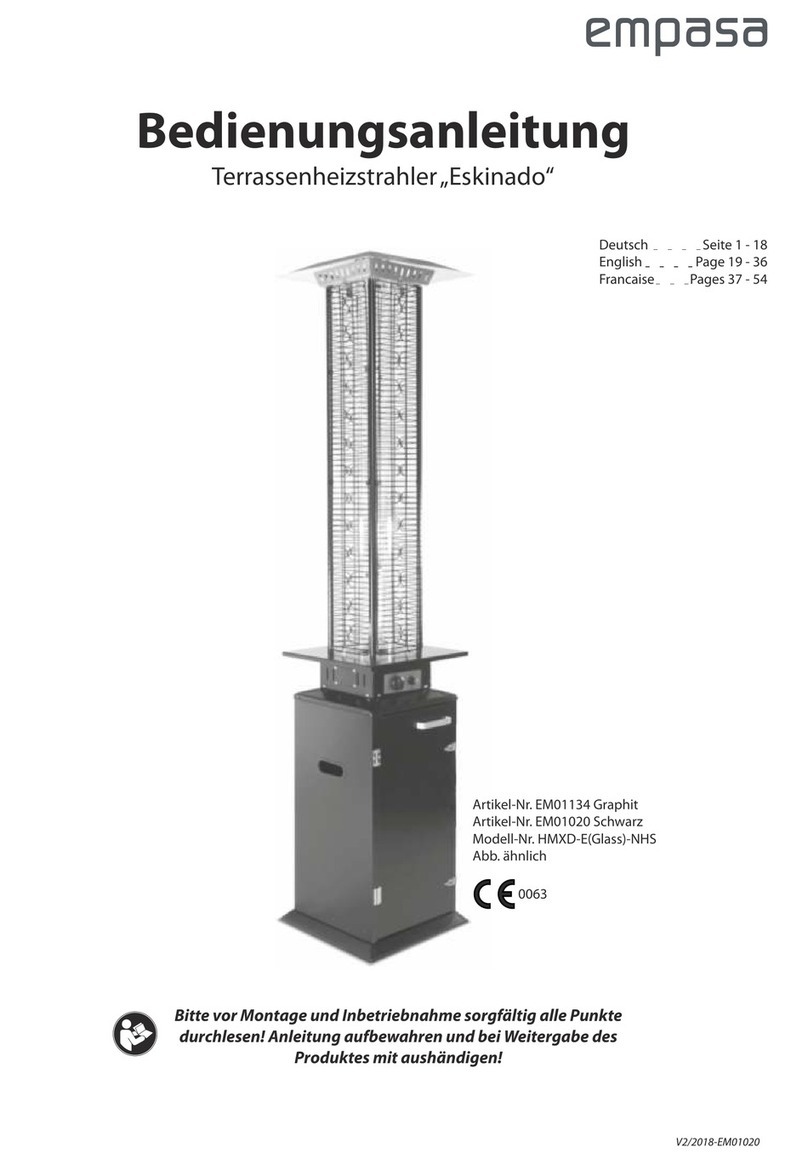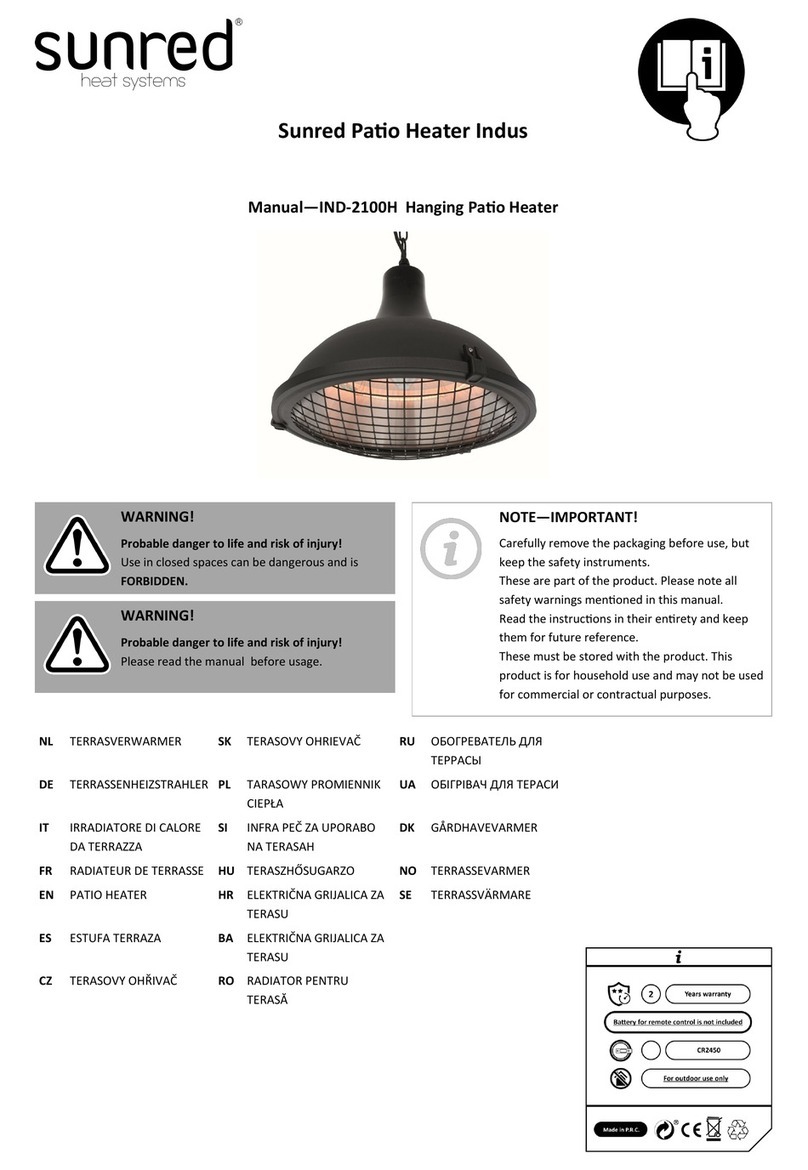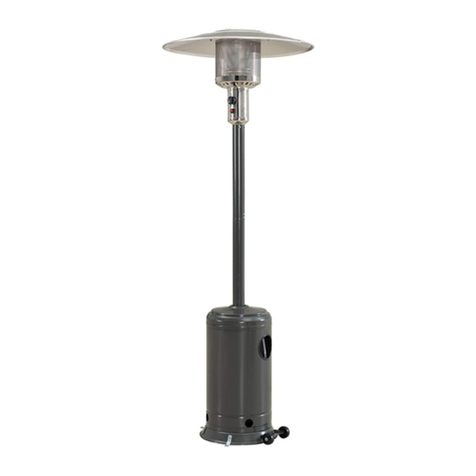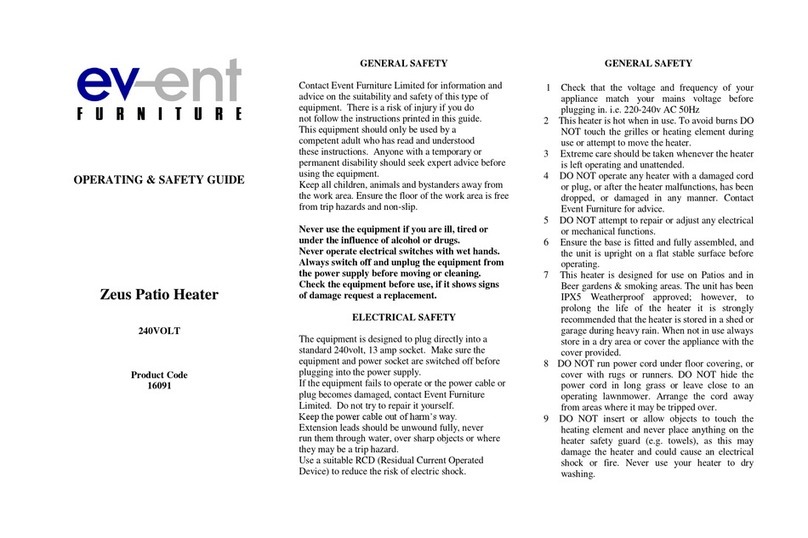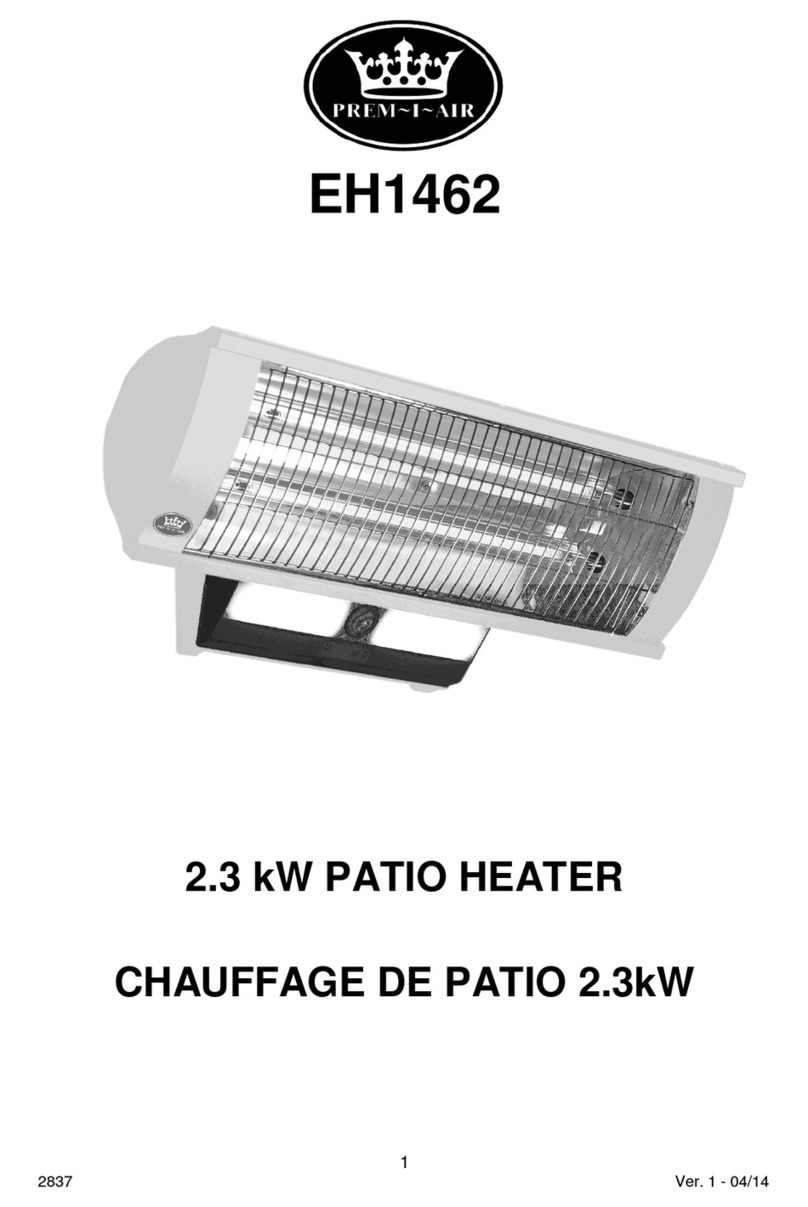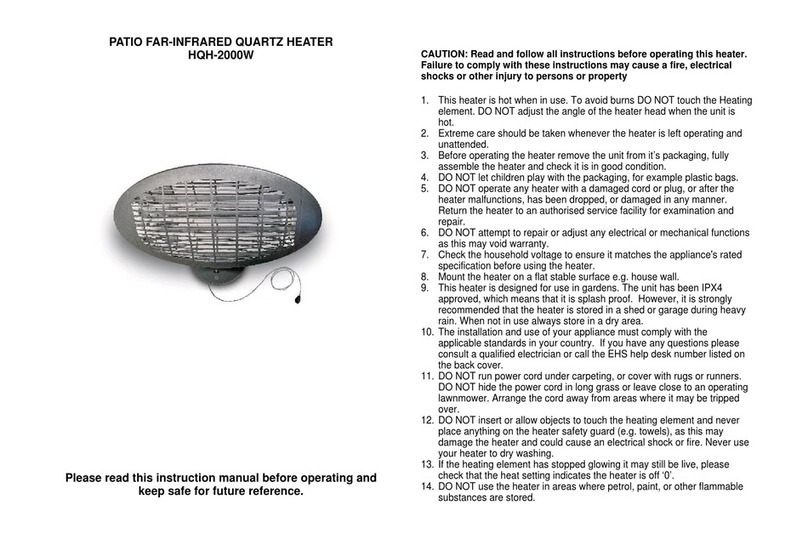
12 13
3. If leak is at regulator/cylinder valve connection:
disconnect, reconnect, and perform another leak check.
If you continue to see bubbles after several attempts,
cylinder valve is defective and should be returned to
cylinder’s place of purchase.
If NO bubbles appear at any connection, the connections
are secure.
NOTE: Whenever gas connections are loosened or
removed, you must perform a complete leak test.
4. Complete installation.
DANGER:
• CARBON MONOXIDE HAZARD
• For outdoor use only. Never use inside house, or other
unventilated or enclosed areas. This heater consumes air
(oxygen). Do not use in unventilated or enclosed areas to
avoid endangering your life.
CAUTION:
Do not attempt to operate until you have read and
understand all General Safety Information in this manual
and all assembly is complete and leak checks have been
performed.
This appliance shall be used only in a well-ventilated
space and shall not be used in a building, garage or any
other enclosed area.
An appliance may be installed with shelter no more
inclusive than:
1)With walls on all sides, but with no overhead cover.
2)Within a partial enclosure which includes an overhead
cover and no more than two side walls. These side walls
may be parallel, as in a breezeway, or at right angles to
each other.
3)Within a partial enclosure which includes an overhead
cover and three side walls, as long as 30 percent or
more of the horizontal periphery of the enclosure is
permanently open.
Before Turning Gas Supply ON:
1. Your heater was designed and approved for outdoor
use only. Do NOT use it inside a building, garage, or any
other enclosed area.
2. Make sure surrounding areas are free of combustible
materials, gasoline, and other flammable vapors or
liquids.
3. Ensure that there is no obstruction to air ventilation. Be
sure all gas connections are tight and there are no leaks.
4. Be sure the cylinder cover is clear of debris. Be sure
any component removed during assembly or servicing is
replaced and fastened prior to starting.
Before Lighting:
1. Heater should be thoroughly inspected before each
use, and by a qualified service person at least annually. If
relighting a hot heater, always wait at least 5 minutes.
2. Inspect the visible portion of the hose before each use
of the appliance. If the hose leaks, it must be replaced
prior to operation. Only use the replacement hose
assembly specified by manufacturer.
3. The pressure regulator and hose assembly supplied
with the appliance must be used. Replacement pressure
regulators and hose assemblies must be those specified
by the appliance manufacturer.
WARNING: FOR YOUR SAFETY
Be careful when attempting to manually ignite this
heater. Holding in the control knob for more than 10
seconds before igniting the gas will cause a ball of flame
upon ignition.
OPERATION CHECKLIST
For a safe and pleasurable heating experience, perform
this check before each use.
1. I am familiar with entire owner’s manual and
understand all precautions noted.
2. All components are properly assembled, intact and
operable.
3. No alterations have been made.
4. All gas connections are secure and do not leak.
5. Wind velocity is below 10 mph.
6. Unit will operate at reduced efficiency below 40°F.
7. Heater is placed outdoors (outside any enclosure).
8. There is adequate fresh air ventilation.
9. Heater is away from gasoline or other flammable
liquids or vapors.
10. Heater is away from windows, air intake openings,
sprinklers and other water sources.
11. Heater is at least 36 in. on top and at least 36 in. on
sides from combustible materials.
12. Heater is on a hard and level surface.
13. There are no signs of spider or insect nests.
14. All burner passages are clear.
15. All air circulation passages are clear.
16. Children and adults should be alerted to the hazards
of high surface temperatures and should stay away to
avoid burns or clothing ignition.
17. Children should be carefully supervised when they are
in the area of the heater.
18. Clothing or other protective material should not be
hung from the heater, or placed on or near the heater.
19. Any guard or other protective device removed for
servicing the heater must be replaced prior to operating
the heater.
20. Installation and repair should be done by a qualied
service person. The heater should be inspected before
use and at least annually by a qualied service person.
21. More frequent cleaning may be required as necessary.
It is imperative that control compartment, burner and
circulating air passageways of the heater be kept clean.
Lighting:
NOTE: This heater is equipped with a pilot light that
allows for safer startups and shutdowns. Pilot must be lit
before main burner can be started.
1. Turn the control knob to the “OFF” position.
2. Fully open LP cylinder valve.
INSTALLATION INSTRUCTIONS OPERATION
3. Open viewing hole by sliding
cover to either side (Figure 1).
4. Push control knob in and
rotate to pilot position (Figure 2).
NOTE: For initial start or after
any cylinder change, hold
control knob in for 2 minutes to
purge air from gas lines before
proceeding.
5. Push and release the igniter
button until pilot flame is visible
through viewing hole.
6. Once the pilot is lit, continue to depress the control
knob for 30 seconds.
7. If the pilot does not stay lit,
repeat steps 4 to 6.
8. If after repeating steps 4 to 6
unit does not light, then
- Push in control knob and turn
to “PILOT” (Figure 3).
- As you are depressing the
control knob, place long stem
lighter into the ignition hole on
the emitter screen to light the
pilot (Figure 4).
- Repeat step 6.
9. Turn the control knob to the
“LOW”, then release control
knob. If you want a higher
temperature, turn the control
knob counterclockwise to the
“HIGH” (Figure 5).
NOTE: Improper operation,
can cause injury or property
damage. If pilot fails to remain
lit, all valves should be closed
and a waiting period of at least
5 minutes should pass before attempting to light.
If you experience any ignition problem please consult
“Troubleshooting”.
CAUTION: Avoid inhaling fumes emitted from the heater’s
first use. Smoke and odor from the burning of oils used
in manufacturing will appear. Both smoke and odor will
dissipate after approximately 30 minutes. The heater
should NOT produce thick black smoke.
NOTE: The burner may be noisy when initially turned on.
To eliminate excessive noise from the burner, turn the
control knob to the PILOT position. Then, turn the knob to
the level of heat desired.
When the heater is ON:
Emitter screen will become bright red due to intense
heat. The color is more visible at night. Burner will display
blue and yellow flame. These flames should not be yellow
or produce thick black smoke, indicating an obstruction
of airflow through the burners. The flame should be blue
with straight yellow tops. If excessive yellow flame is
detected, turn off heater and consult “Troubleshooting”.
Re-lighting:
NOTE: For your safety, control knob cannot be turned OFF
without first depressing control knob in PILOT position
and then rotating it to OFF.
1. Turn control knob to OFF.
2. Wait at least 5 minutes to let gas dissipate, before
attempting to relight Pilot.
3. Repeat the “Lighting” steps on prior page.
WARNING: Heater will be hot aer use. Handle with
extreme care.
Shut Down:
1. Turn control knob clockwise to PILOT. Normally, burner
will make a slight popping sound when extinguished.
Burner will extinguish but PILOT will remain ON.
2. To extinguish PILOT, depress control knob and continue
to turn it clockwise to OFF.
3. Turn cylinder valve clockwise to OFF and disconnect
regulator when heater is not in use.
NOTE: After use, some discoloration of the emitter screen
is normal.
AFTER OPERATION
1. Gas control is turned OFF.
2. Gas Tank valve is turned OFF.
3. Disconnect Gas line.
Figure 1
Figure 2
Figure 3
Figure 4
Figure 5
in.
in.
in.
in.
in.
in.
Normal Abnormal


